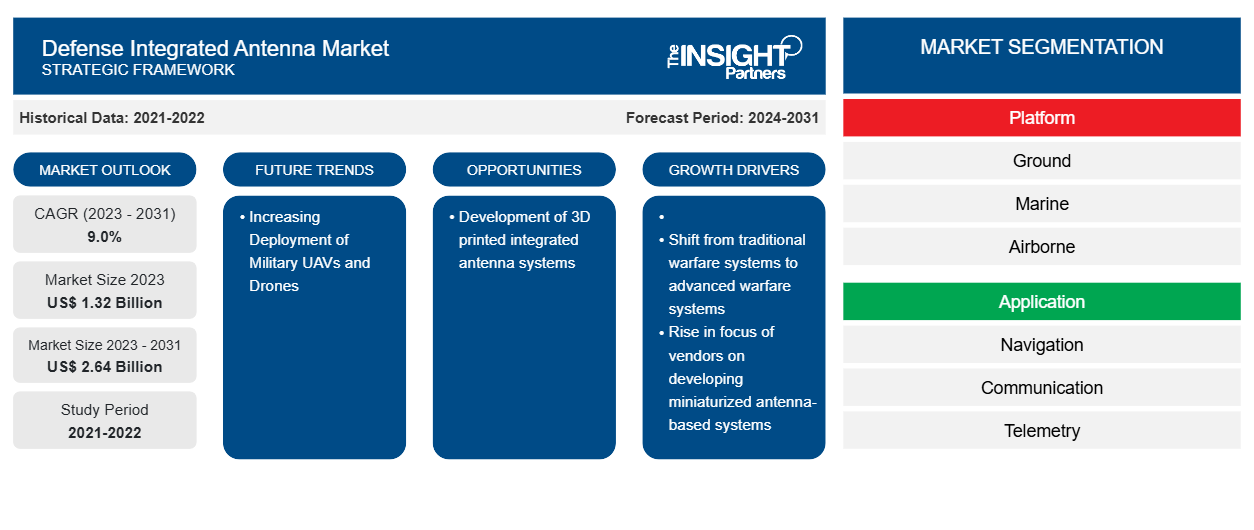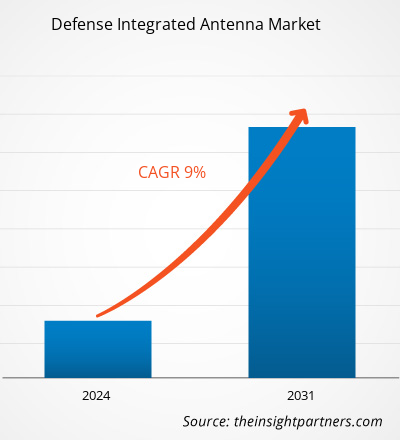The defense integrated antenna market size is projected to reach US$ 2.64 billion by 2031 from US$ 1.32 billion in 2023. The market is expected to register a CAGR of 9.0% during 2023–2031. Development of 3D printed integrated antenna systems is likely to remain a key trend in the market.
Defense Integrated Antenna Market Analysis
The defense integrated antenna market ecosystem comprises the following stakeholders – raw material supplier, defense integrated antenna manufacturers, and end users. The raw material suppliers provide high quality material, such as the transistors, receivers, high temperature internal components, and RTV silicon seals, to defense integrated antenna manufacturers for production of highly efficient and cost-effective defense integrated antenna. The expansion of semiconductor industry has led to the emergence various raw material suppliers, such as collaborating with defense integrated antenna manufacturers.
Defense Integrated Antenna Market Overview
The defense integrated antenna manufacturers are engaged in various processes, including designing, assembling, and production, to transform the raw material into finished products and additionally integrating the components to the entire devices. L3Harris Technologies Inc.; Thales Group; Honeywell International Inc. are some of the leading global defense integrated antenna manufacturers. These companies are offering high quality defense integrated antenna and systems to end users, which they install in different devices such as radar systems, communication devices among others. The end-users are the large number of customers, ranging from military component manufacturers to satcom equipment manufacturers.
Customize This Report To Suit Your Requirement
You will get customization on any report - free of charge - including parts of this report, or country-level analysis, Excel Data pack, as well as avail great offers and discounts for start-ups & universities
Defense Integrated Antenna Market: Strategic Insights

-
Get Top Key Market Trends of this report.This FREE sample will include data analysis, ranging from market trends to estimates and forecasts.
Defense Integrated Antenna Market Drivers and Opportunities
Rising Focus on the Development of Miniaturized Antenna-Based Systems
Integrated antennas are used in small military aircraft (including military trainer aircraft), unmanned aerial vehicles (UAVs), surveillance vehicles, warfare systems, navigation systems, and communication systems. Due to the increasing requirement for antennas that take less space, the antenna manufacturers are increasing their focus on developing miniature integrated antennas. For instance, L3 Harris offers a miniature multiband directional (MMD) antenna for ground-based operations. This antenna establishes reliable, only receivable data links for the static operations. It is a low-SWaP antenna that delivers range across L, S, C, and KU frequency bands in a single compact unit.
Increasing Deployment of Military UAVs and Drones
UAVs are being used for various applications, such as search & rescue, remote monitoring, and surveillance. Using a wireless link to transfer information from a UAV to a ground station is difficult for such applications. Antennas are the most vital part of the wireless link, so they must be designed in such a way that they effortlessly integrate with the UAV without affecting it. For this, the antenna should be lightweight, thin, conformal, and can provide wide coverage. Various military forces are deploying UAVs, increasing the demand for integrated antenna systems. For instance, in January 2022, The Brazilian Air Force signed a contract with AEL Sistemas. Under this contract, AEL Sistemas will provide two Hermes 900 (RQ-900 in Brazil service) multirole medium-altitude long-endurance UAVs and their spare parts to the Brazilian Air Force.
Defense Integrated Antenna Market Report Segmentation Analysis
Key segments that contributed to the derivation of the defense integrated antenna market analysis are platform, application, and frequency.
- Based on platform, the defense integrated antenna market is divided into ground, marine, and airborne. The ground segment held a larger market share in 2023.
- Based on application, the defense integrated antenna market is segmented into navigation, communication, and telemetry. The communication segment held a larger market share in 2023.
- By frequency, the market is segmented into HF/VFH/UHF-band, L-band, Ku & Ka band, S-band, and multi-band. The Ku & Ka band segment held the largest share of the market in 2023.
- In terms of platform, the market is segmented into armored vehicles, unmanned systems, handheld systems, aircraft systems, ships and submarines, and others. The armored vehicles segment held a significant share of the market in 2023.
Defense Integrated Antenna Market Share Analysis by Geography
The geographic scope of the defense integrated antenna market report is mainly divided into five regions: North America, Europe, Asia Pacific, Middle East & Africa, and South America.
North America has dominated the market in 2023 followed by Europe and Asia Pacific region. During the projected period, North America is predicted to dominate the worldwide defense integrated antenna market and increase at a rapid CAGR, followed by Europe. The bulk of rising economies in North America are highest military expenditure-driven economies. As military equipment manufacturing firms are conducting extensive research and development in advance military communication systems, the market in North America is expected to rise at a rapid pace throughout the projected period.
Defense Integrated Antenna Market Regional Insights
The regional trends and factors influencing the Defense Integrated Antenna Market throughout the forecast period have been thoroughly explained by the analysts at The Insight Partners. This section also discusses Defense Integrated Antenna Market segments and geography across North America, Europe, Asia Pacific, Middle East and Africa, and South and Central America.
Defense Integrated Antenna Market Report Scope
| Report Attribute | Details |
|---|---|
| Market size in 2023 | US$ 1.32 Billion |
| Market Size by 2031 | US$ 2.64 Billion |
| Global CAGR (2023 - 2031) | 9.0% |
| Historical Data | 2021-2022 |
| Forecast period | 2024-2031 |
| Segments Covered |
By Platform
|
| Regions and Countries Covered |
North America
|
| Market leaders and key company profiles |
|
Defense Integrated Antenna Market Players Density: Understanding Its Impact on Business Dynamics
The Defense Integrated Antenna Market is growing rapidly, driven by increasing end-user demand due to factors such as evolving consumer preferences, technological advancements, and greater awareness of the product's benefits. As demand rises, businesses are expanding their offerings, innovating to meet consumer needs, and capitalizing on emerging trends, which further fuels market growth.

- Get the Defense Integrated Antenna Market top key players overview
Defense Integrated Antenna Market News and Recent Developments
The defense integrated antenna market is evaluated by gathering qualitative and quantitative data post primary and secondary research, which includes important corporate publications, association data, and databases. A few of the developments in the defense integrated antenna market are listed below:
Raytheon, an RTX (NYSE: RTX) business, will design, build and test two high-power microwave antenna systems that will use directed energy to defeat airborne threats at the speed of light. The systems are designed to be rugged and transportable for front-line deployment. (Source: Raytheon Technologies, Press Release, Dec 2023)
- L3Harris Technologies (NYSE:LHX) has successfully completed a technology demonstration, under a Defense Innovation Unit prototype contract, for the U.S. Space Force satellite communication system to improve communications with the agency’s growing number of satellites. (Source: L3Harris Technologies Inc, Press Release, Jan 2021)
Defense Integrated Antenna Market Report Coverage and Deliverables
The “Defense Integrated Antenna Market Size and Forecast (2021–2031)” report provides a detailed analysis of the market covering below areas:
- Defense integrated antenna market size and forecast at global, regional, and country levels for all the key market segments covered under the scope
- Defense integrated antenna market trends as well as market dynamics such as drivers, restraints, and key opportunities
- Detailed porter’s five forces analysis
- Defense integrated antenna market analysis covering key market trends, global and regional framework, major players, regulations, and recent market developments
- Industry landscape and competition analysis covering market concentration, heat map analysis, prominent players, and recent developments for the defense integrated antenna market
- Detailed company profiles
Frequently Asked Questions
Which region dominated the defense integrated antenna market in 2023?
What are the driving factors impacting the defense integrated antenna market?
What are the future trends of the defense integrated antenna market?
Which are the leading players operating in the defense integrated antenna market?
What would be the estimated value of the defense integrated antenna market by 2031?
What is the expected CAGR of the defense integrated antenna market?
- Historical Analysis (2 Years), Base Year, Forecast (7 Years) with CAGR
- PEST and SWOT Analysis
- Market Size Value / Volume - Global, Regional, Country
- Industry and Competitive Landscape
- Excel Dataset
Recent Reports
Related Reports
Testimonials
Reason to Buy
- Informed Decision-Making
- Understanding Market Dynamics
- Competitive Analysis
- Identifying Emerging Markets
- Customer Insights
- Market Forecasts
- Risk Mitigation
- Boosting Operational Efficiency
- Strategic Planning
- Investment Justification
- Tracking Industry Innovations
- Aligning with Regulatory Trends





















 Get Free Sample For
Get Free Sample For